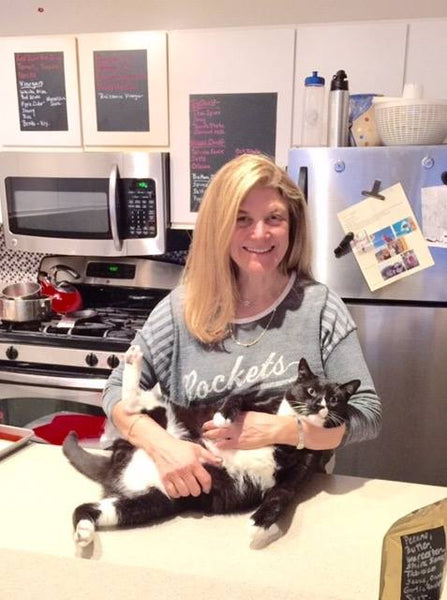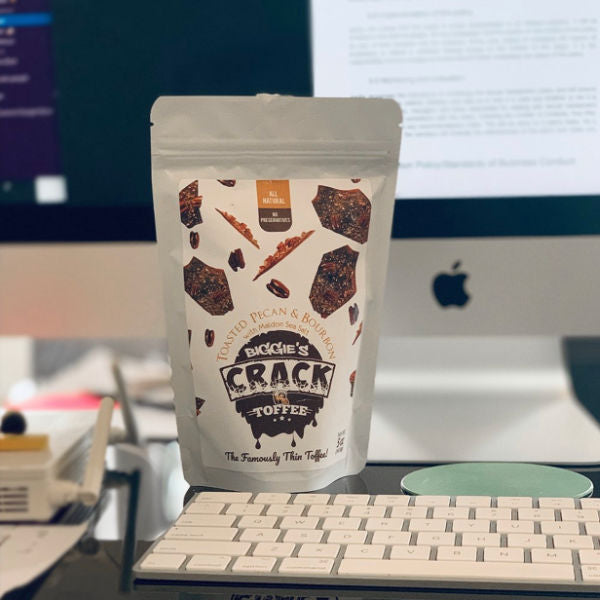Photos: Biggie's Crack Toffee
What do you treasure? For many of us, 2020 has been the Zen (or not so Zen) retreat no one asked for. The pandemic has created havoc across all sectors of the economy and healthcare system, and has transformed the way we learn, work, interact, and live. We’re all spending a lot more time at home, and the way we spend — and even appreciate — that time has changed dramatically.
It seems many of us are thinking more deeply than we have, perhaps ever, about what we value and prioritize.
Inevitably, that — along with the economic pressures COVID has introduced — has meant a number of small businesses have closed their doors. Even under normal circumstances, 20 percent of small businesses fail in their first year, 30 percent in their second, and 50 percent after five years in business. An astounding 70 percent shut their doors in their tenth year, according to the most recent data from the Bureau of Labor Statistics. The pandemic has almost certainly accelerated that trend.
We sat down with Stephanie Golden, founder of Biggie’s Crack Toffee and one of our former makers, to find out why she chose to close what many outsiders saw as her wildly successful small business.
NEW YORK MAKERS: First, I’d love to hear more about Biggie’s Crack Toffee, and how you started making it.
STEPHANIE GOLDEN: It started as a hobby. Biggie’s Crack Toffee, a unique toffee candy, with a crackling thin texture crunchy buttery toffee flavors, which can feature different flavors and textures. I made it for friends and family and they went crazy for it, and told me I had to start selling it. My story is very much like other accidental entrepreneurs who have a product and, through enthusiastic friends and luck, find a market for it. I started selling it to small stores, and then I happened to give it to a friend who worked at Hearst, who then had Oprah Winfrey try it.

Stephanie Golden and her cat, Biggie
NYM: What did Oprah think?
SG: She picked it as one of her Favorite Things in 2016 for The Oprah Magazine.
NYM: That must have been a coup for the business!
SG: It was insane! So many people follow Oprah’s gift guide, and it launched my business like a rocket-ship. But I never quit — and never wanted to quit — my job in finance because I enjoyed it and it provided financial stability that Biggie’s Toffee wouldn’t have been able to provide for years, maybe ever. The reality is, when you’re a small business, you often have to operate at a deficit when you want to grow in the beginning. With the orders rolling in, we were off to the races, but that meant I had to buy machinery and figure out how to scale production up. I was working at night and on the weekends, and for three months I was getting maybe four hours of sleep a night. I hired part-timers to help me make the toffee, but I was doing the marketing and making all of the sales and financial decisions.

NYM: It’s hard to believe that you were operating at a loss when Biggie’s looked so successful from afar!
SG: I know, but, speaking to other entrepreneurs who are considered successful, it’s a common story. There’s a lot of magical thinking in the entrepreneurial world, but good press doesn’t necessarily lead to financial success, especially immediately. I appeared on The View, and, while it was a great experience, part of the deal entailed selling my toffee on-air for a significant discount. But in return, I found a whole new audience. So it is a trade-off, and a fair one perhaps, but in the end, I knew that selling the toffee for $10 a box, our normal sales price, would never make us profitable. And I didn’t want to turn our toffee production process into something that wasn’t inherently artisanal. Even when we got bigger machines and processed huge orders, we were still making relatively small batches, tempering chocolate, doing much of it by hand. I didn’t want to lose that. And for me, I couldn’t rationalize charging $15 for the toffee. I mean, I’d pay that, and I regularly do, for an artisanal food product. But how many other people would, or could reasonably afford to? I really struggled with that philosophically.
NYM: I’m guessing that even after hiring people and acquiring machines, you were still essentially working two full time jobs.
SG: Yes, time was increasingly becoming an issue. Don’t get me wrong — this is what I do. I find things and I turn them into my life. I did a film in the 2000s that went to Sundance, and it was great, but it didn’t make me want to quit my job and work in film. I look at these experiences as just that, wonderful experiences with beginnings, middles, and ends.

NYM: How did you decide it was time to end your journey with Biggie’s Crack Toffee?
SG: I gave myself a lot of time to make that decision. I think that’s key. It was clearly never going to be a real money-maker, unless I changed the price structure. And I decided I wasn’t comfortable with that. I also realized that I wanted that time back. I want to knit, and read, and relax. I love to cook, I love to spend time — virtually now — with friends. I think it’s important to not be afraid to let things go, and to listen to yourself. Is this bringing you joy? Is it something that improves your life? Success doesn’t have to be monetary, but letting something that is no longer bringing you joy go, doesn’t mean you failed. It means you’re moving on. It was time to let the business go, but I’m glad I had the experience, and I’ll always be grateful to Oprah and my other early supporters. It was incredible; but now I’m ready for my next experience.
Time, and what we do with it, may indeed be the greatest treasure of all.


Leave a comment